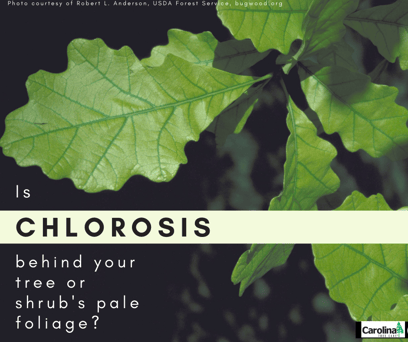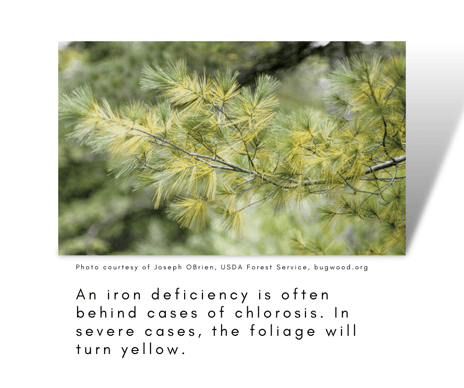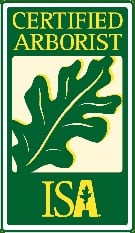You've enjoyed watching your yard come back to life over the last few weeks. But wait a minute — are the once vibrant green leaves of your tree or shrub now a lot paler? It could be suffering from a condition called chlorosis.
What is chlorosis and how can you get your leaves their greenest green again? We've got the answers you're looking for!

Don't ignore pale leaves
To understand chlorosis, we need to talk about chlorophyll, the compound that makes leaves green. Chlorophyll helps plants absorb energy from sunlight, so it's vital for photosynthesis.
Chlorosis occurs when the plant doesn't have enough chlorophyll. It leads to foliage looking a lot less green than it should be.
Why do plants become chlorotic?
Many times, an iron deficiency is what leads to chlorosis. Plants need iron to make chlorophyll, but sometimes a plant can't get the iron it needs from the soil. This can happen because there isn't enough iron in the soil, or the roots can't absorb the iron for some reason.
Some common reasons why plants end up unable to absorb iron from the soil include:
- Poor drainage
- Damaged roots or compacted soil
- High alkalinity (pH) of the soil
You may notice chlorosis first on the younger, lower, and/or terminal leaves of your tree or shrub, and it may spread inward to older leaves over time.
If the foliage of your tree or shrub is a paler green than normal, you're probably dealing with a mild case of chlorosis. Yellow foliage is an indication of a more severe case. And in very severe cases, the outer edges of the foliage will scorch and turn brown as plant cells die.

How to deal with chlorosis in your Charlotte, NC yard
Maples, hollies, river birches, azaleas, rhododendrons, yews, and oaks in the Charlotte, NC area are especially susceptible to chlorosis.
If iron deficient soil is suspected to be the problem, we can treat chlorosis by giving the tree or shrub the iron it needs. We typically do this by applying a chelated iron treatment to the root zone.
In more severe cases, we may also directly inject iron into the plant.
If we determine that there's a soil pH problem, the treatment may include lowering the pH within the root zone via sulfur-based treatments.
For deciduous trees and shrubs, the best time for a chelated iron treatment is between April and August. For evergreens, we can apply the treatment year-round (as weather conditions permit). We can also perform sulfur-based treatments year-round to lower the pH of the soil surrounding deciduous and evergreen trees.
But what if your tree or shrub's roots can't absorb the iron because of compacted soil and/or poor drainage? We have a solution for that, too. Read about our root rehabilitation services here.
It's important to ensure that your tree or shrub gets enough water after treating for chlorosis, whether that's through rainfall or supplemental irrigation.
Think your trees or shrubs could be suffering from chlorosis? Request a consultation today to let our experts take a closer look!
Like what you just read?
Then you'll love this: Cool Season Spider Mite FAQ







